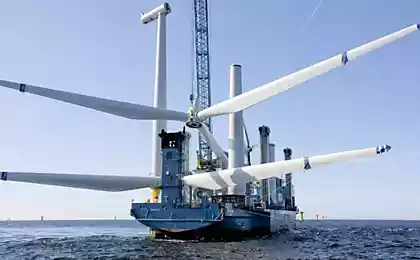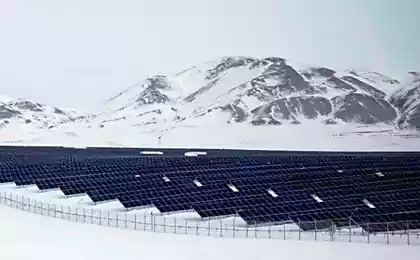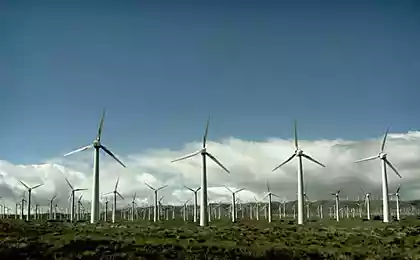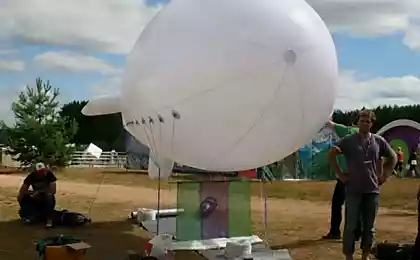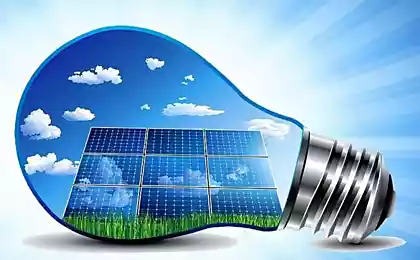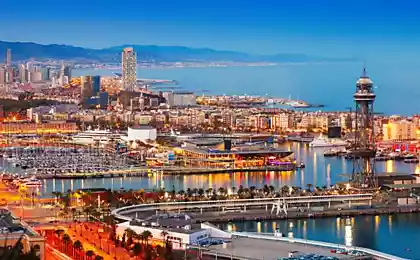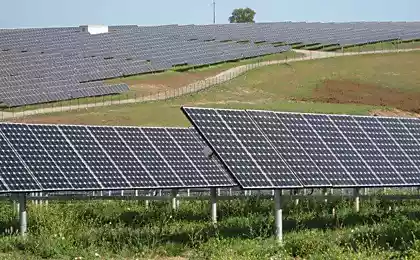507
Clean air, light and heat – the best of the alternative energy sources
More and more our lives affect the ecology. The level of development of medicine has much less impact on our health than the quality of the environment. As it is impossible to name modern environmentally friendly sources of energy thermal, hydro and nuclear power plants. And only the development of alternative sources of energy resources can help Russia emerge from the socio-economic crisis and take the path of rapid development.

The majority of renewable energy is evenly distributed and the biggest development in their use reach countries with highly skilled workers, a positive attitude towards innovation and effectively built financial system. And it is already clear that one of the main features of the energy of the XXI century will be the reduction in the level of dependence of the energy consumers from centralized power supply systems. The distribution of the areas of decentralized energy supply is not quite uniform and the lion's share of them are located in the North of Russia. According to energy specialists, the impossible is the solution to the problems of energy in Northern areas, only by large power system engineering.
The energy reserves of the Northern part of Russia, are mostly from coal, wood and fuel oil, that is raw material is very expensive and environmentally dirty. Due to this increasingly serious problem of energy transfer North to environmentally friendly materials. The process of greening must be based on renewable energy resources, build wind farms, hydro and thermal power plants. And the main needs of the sparsely populated North is the need for a decentralized system of Autonomous energy supply and independence from supplies of expensive fossil fuels.
In our time, is a very wide range of possibilities of new technologies. An example is the course of their development, from the big electronic computing to modern ultrabooks and other things. All of these devices have great functionality and capabilities.
If you compare the XX and XXI century, the first one can be safely called "oil", and the second rightly will be known as the century of hydrogen energy. According to many reputable scientists, if you find a way easy and effective water electrolysis, hydrogen could be turned into the main energy carrier in the near future. Thus, for fuel cells opens up new prospects of application. After all, if you think about it, these elements are used everywhere in the smartphones, tablets and laptops, businesses, military bases and hospitals, as well as in cars.
To reduce the distance between the consumer and the energy source can significantly promote the use of small fuel cells and various renewable sources of alternative energy, and it will provide an opportunity to decentralize the energy system.
Solar power and wind turbines are most effective in small settlements, which are remote from centralized power supply systems. They work thanks to the energy of wind and sun and can be considered as the cheapest source of electricity. A perfect example of the effective use of these energy sources is Denmark, she's scattered in the many Islands that are difficult to combine through a centralized power system.
For today in Denmark 6% of all domestically produced energy is extracted through 4 thousands of wind turbines. In favor of this type of energy production we can say that it is environmentally friendly and fairly cheap. In the 1990s, 1 kW of energy cost there is one Swedish Krona, in our time, four times cheaper. These figures markedly less than that of nuclear and thermal power plants, and even cheap hydro power, which is produced in Sweden.
The popularity of Danish wind turbines is quite large, but only half of the demand they satisfy exactly the Danish manufacturers. With the advent of new postindustrial era vision of the Danish government has been very successful, and his help has allowed wind energy to develop the field quickly enough. As you know Russia has a huge potential of wind energy for the development of this sector. According to the research of wind turbines is most effective only when the average wind speed of 5m/s and above. Such conditions exist along the shores of the Arctic ocean. 12 thousand km of sparsely populated area dominated by the winds, the speed of which is equal to approximately 5-7 m/s. In the North the total capacity of the wind just a whopping 45 billion kWh.
Great operate wind farms on the Islands of Bering, Schmidt, Wrangel island, Novaya Zemlya and Cape Uelen. There are wind turbines with great success replacing diesel power stations, the operation of which need to buy expensive imported fuel. For diesel power plants in Northern Canada alone fuel delivery costs two times more than the cost of fuel. Except for the wind industry in the North also actively use and develop energy from tides.
An example of such production of energy in Russia can be considered the Kislogubskaya tidal power plant, built on the shore of the Kola Peninsula. Thanks to the experience of the use of this station, we developed a new solution for the construction of a tidal power plant on Kola Peninsula, the power will be 40 MW. There is also the prospect of building tidal power plants in Torgerson and Penzhina bays located in the sea of Okhotsk, preliminary calculations show that the capacity of these stations is from 6 to 24 million kW.
In Sweden, Finland, Alaska and Canada, an increasingly often used solar power. By 2000, 5% of supply Canadian North received from solar energy. Over the past 20 years the construction costs of solar cells decreased there by 80% and it's all thanks to the efficiency and quality of materials. These days to obtain electricity from solar energy in individual homes and buildings, as frequent practice of embedding solar cells in the window stele, tiles and ceramic slabs. For the period from 1985 to 1999, the total capacity of solar panels in the world has increased from 150 MW to 900 MW.
minor experience when working with solar power plants showed that in the conditions of polar day huge benefits as passive use of solar energy, for example to enhance the heat insulation and passive heating systems, such as solar collectors filled with water. Its value is not lost and active systems of solar cells, which operate well in cloudy weather conditions.
Not just now, as in the past century, people have mastered the skill of getting from superheated volcanic steam cheap geothermal electricity. Academician of Belarus Gerasim Bogomolov in the 1970-ies suggested using the heat of underground water resources. But at that time this idea was not relevant, since in those days the cost of extraction and processing of petroleum products was quite low. Even the most ordinary glass of soda cost less than a Cup of gasoline. But in our time, scientists consider it necessary to pay attention to the energy of the underground currents. And with the advent of the threat of so-called "energy hunger" of interest to this type of energy has grown rapidly.
Although, over the last 15-20 years one can note a trend to a sharp decrease in the use of geothermal energy. By the end of the 90-ies of Geothermal power has decreased worldwide doubled to 3.6 million kW. The reason for this are several factors: the first is the negative impact of the environment on the whole, the second – the complexity of the operation, but the third factor is the rapidly growing cost of 1 kW of power.
Everything else geothermal energy is most often tied to the place of its production, it is not mobile and sometimes located in rather inaccessible places, except in this case can be considered only Iceland. To the list of difficulties also can add to the high mineralization of geothermal water, in some places it reaches as much as 400 g per liter. This may result in clogging of the wells.
International experience of energy supply you can find a lot of interesting features regarding the structure and operation of all types of alternative energy sources, and costs are associated with it.
Source: zeleneet.com

The majority of renewable energy is evenly distributed and the biggest development in their use reach countries with highly skilled workers, a positive attitude towards innovation and effectively built financial system. And it is already clear that one of the main features of the energy of the XXI century will be the reduction in the level of dependence of the energy consumers from centralized power supply systems. The distribution of the areas of decentralized energy supply is not quite uniform and the lion's share of them are located in the North of Russia. According to energy specialists, the impossible is the solution to the problems of energy in Northern areas, only by large power system engineering.
The energy reserves of the Northern part of Russia, are mostly from coal, wood and fuel oil, that is raw material is very expensive and environmentally dirty. Due to this increasingly serious problem of energy transfer North to environmentally friendly materials. The process of greening must be based on renewable energy resources, build wind farms, hydro and thermal power plants. And the main needs of the sparsely populated North is the need for a decentralized system of Autonomous energy supply and independence from supplies of expensive fossil fuels.
In our time, is a very wide range of possibilities of new technologies. An example is the course of their development, from the big electronic computing to modern ultrabooks and other things. All of these devices have great functionality and capabilities.
If you compare the XX and XXI century, the first one can be safely called "oil", and the second rightly will be known as the century of hydrogen energy. According to many reputable scientists, if you find a way easy and effective water electrolysis, hydrogen could be turned into the main energy carrier in the near future. Thus, for fuel cells opens up new prospects of application. After all, if you think about it, these elements are used everywhere in the smartphones, tablets and laptops, businesses, military bases and hospitals, as well as in cars.
To reduce the distance between the consumer and the energy source can significantly promote the use of small fuel cells and various renewable sources of alternative energy, and it will provide an opportunity to decentralize the energy system.
Solar power and wind turbines are most effective in small settlements, which are remote from centralized power supply systems. They work thanks to the energy of wind and sun and can be considered as the cheapest source of electricity. A perfect example of the effective use of these energy sources is Denmark, she's scattered in the many Islands that are difficult to combine through a centralized power system.
For today in Denmark 6% of all domestically produced energy is extracted through 4 thousands of wind turbines. In favor of this type of energy production we can say that it is environmentally friendly and fairly cheap. In the 1990s, 1 kW of energy cost there is one Swedish Krona, in our time, four times cheaper. These figures markedly less than that of nuclear and thermal power plants, and even cheap hydro power, which is produced in Sweden.
The popularity of Danish wind turbines is quite large, but only half of the demand they satisfy exactly the Danish manufacturers. With the advent of new postindustrial era vision of the Danish government has been very successful, and his help has allowed wind energy to develop the field quickly enough. As you know Russia has a huge potential of wind energy for the development of this sector. According to the research of wind turbines is most effective only when the average wind speed of 5m/s and above. Such conditions exist along the shores of the Arctic ocean. 12 thousand km of sparsely populated area dominated by the winds, the speed of which is equal to approximately 5-7 m/s. In the North the total capacity of the wind just a whopping 45 billion kWh.
Great operate wind farms on the Islands of Bering, Schmidt, Wrangel island, Novaya Zemlya and Cape Uelen. There are wind turbines with great success replacing diesel power stations, the operation of which need to buy expensive imported fuel. For diesel power plants in Northern Canada alone fuel delivery costs two times more than the cost of fuel. Except for the wind industry in the North also actively use and develop energy from tides.
An example of such production of energy in Russia can be considered the Kislogubskaya tidal power plant, built on the shore of the Kola Peninsula. Thanks to the experience of the use of this station, we developed a new solution for the construction of a tidal power plant on Kola Peninsula, the power will be 40 MW. There is also the prospect of building tidal power plants in Torgerson and Penzhina bays located in the sea of Okhotsk, preliminary calculations show that the capacity of these stations is from 6 to 24 million kW.
In Sweden, Finland, Alaska and Canada, an increasingly often used solar power. By 2000, 5% of supply Canadian North received from solar energy. Over the past 20 years the construction costs of solar cells decreased there by 80% and it's all thanks to the efficiency and quality of materials. These days to obtain electricity from solar energy in individual homes and buildings, as frequent practice of embedding solar cells in the window stele, tiles and ceramic slabs. For the period from 1985 to 1999, the total capacity of solar panels in the world has increased from 150 MW to 900 MW.
minor experience when working with solar power plants showed that in the conditions of polar day huge benefits as passive use of solar energy, for example to enhance the heat insulation and passive heating systems, such as solar collectors filled with water. Its value is not lost and active systems of solar cells, which operate well in cloudy weather conditions.
Not just now, as in the past century, people have mastered the skill of getting from superheated volcanic steam cheap geothermal electricity. Academician of Belarus Gerasim Bogomolov in the 1970-ies suggested using the heat of underground water resources. But at that time this idea was not relevant, since in those days the cost of extraction and processing of petroleum products was quite low. Even the most ordinary glass of soda cost less than a Cup of gasoline. But in our time, scientists consider it necessary to pay attention to the energy of the underground currents. And with the advent of the threat of so-called "energy hunger" of interest to this type of energy has grown rapidly.
Although, over the last 15-20 years one can note a trend to a sharp decrease in the use of geothermal energy. By the end of the 90-ies of Geothermal power has decreased worldwide doubled to 3.6 million kW. The reason for this are several factors: the first is the negative impact of the environment on the whole, the second – the complexity of the operation, but the third factor is the rapidly growing cost of 1 kW of power.
Everything else geothermal energy is most often tied to the place of its production, it is not mobile and sometimes located in rather inaccessible places, except in this case can be considered only Iceland. To the list of difficulties also can add to the high mineralization of geothermal water, in some places it reaches as much as 400 g per liter. This may result in clogging of the wells.
International experience of energy supply you can find a lot of interesting features regarding the structure and operation of all types of alternative energy sources, and costs are associated with it.
Source: zeleneet.com



